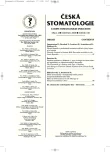The Treatment of a Patient with Type 1 Diabetes and Allergy to Titanium Dental Implants from Zircon Oxide Ceramics
Authors:
R. Šmucler 1,2
Authors‘ workplace:
Stomatologická klinika 1. LF UK a VFN, Praha
1; ASKLEPION-Lasercentrum, Praha
2
Published in:
Česká stomatologie / Praktické zubní lékařství, ročník 108, 2008, 4, s. 91-94
Overview
The objective of the work was to describe an unusual case report of a patient with Type 1 diabetes, who eliminated the primarily stable titanium implants (within the time lapse of several weeks after lege artis - performed operation) due to multiple allergy to metals and was later treated with ceramic implants on the basis of zirconium oxide (ZrO₂). Later on the patient was treated with immediate fixed splint composite bridge. Six months later the prosthetic work was taken off, stability of the healed implants was measured and a final treatment was performed using an all-ceramic fixed splint bridge from a zirconium ceramic. This rare case history will be difficult to verify by sufficiently randomized group in view of the scarceness as indicated by lacking available world literature. If such conclusion may be drawn from this rare case, the treatment of a patient with allergy to titanium and Type 1 diabetes with zirconium oxide implants appear to be a possible therapeutic alternative.
Key words:
dental implant - allergy - titanium - diabetes - zirconium oxide
Sources
1. Balshi, S. F., Wolfinger, G. J., Balshi, T. J.: An examination of immediately loaded dental implant stability in the diabetic patient using resonance frequency analysis (RFA). Quintessence International, 38, 2007, 4, s. 71-279.
2. Blaschke, C., Volz, U.: Soft hard tissue response to zirconium dioxide dental implants - A clinical study in man. Neuroendocrinology Letters, 27, 2006, s. 69-72.
3. Degidi, M. et al.: Inflammatory infiltrate, microvessel density, nitric oxide synthase expression, vascular endothelial growth factor expression, and proliferative activity in peri-implant soft tissues around titanium and zirconium oxide healing caps. Journal of Periodontology, 77, 2006, 1, s. 73-80.
4. Fiorellini, J. P. et al.: The effect of insulin therapy on osseointegration in a diabetic rat model. Clinical Oral Implants Research, 10, 1999, 5, s. 362-368.
5. Franchi, M. et al.: Influence of different implant surfaces on peri-implant osteogenesis: Histomorphometric analysis in sheep. Journal of Periodontology, 78, 2007, 5, s. 879-888.
6. Jirkovská A., Dušková J.: Doporučení diabetologa pro stomatologickou péči o diabetiky. Čes. Stomat., 97, 1997, s. 183-186.
7. Klokkevold, P. R., Han, T. J.: How do smoking, diabetes, and periodontitis affect outcomes of implant treatment? International Journal of Oral & Maxillofacial Implants, 22, 2007, s. 173-198.
8. Moy, P. K. et al.: Dental implant failure rates and associated risk factors. International Journal of Oral & Maxillofacial Implants, 20, 2005, 4, s. 569-577.
9. Muller, K., Valentine-Thon, E.: Hypersensitivity to titanium: Clinical and laboratory evidence. Neuroendocrinology Letters, 27, 2006, s. 31-35.
10. Oliva, J., Oliva, X. V., Oliva, J. D.: One-year follow-up of first consecutive 100 zirconia dental implants in humans: A comparison of 2 different rough surfaces. International Journal of Oral & Maxillofacial Implants, 22, 2007, 3, s. 430-435.
11. Schuh, A. et al.: Allergic potential of titanium implants. Orthopade, 34, 2005, 4, s. 327.
12. Sugerman, P. B., Barber, M. T.: Patient selection for endosseous dental implants: Oral and systemic considerations. International Journal of Oral & Maxillofacial Implants, 17, 2002, 2, s. 191-201.
13. Takeshita, F. et al.: The effects of diabetes on the interface between hydroxyapatite implants and bone in rat tibia. Journal of Periodontology, 68, 1997, 2, s. 180-185.
14. Thomas, R., Maier, S., Summer, B.: Allergic reactions to metal implants. Materialwissenschaft Und Werkstofftechnik, 35, 2004, 12, s. 997-1000.
15. Valentine-Thon, E., Schiwara, H. W.: Validity of MELISA (R) for metal sensitivity testing. Neuroendocrinology Letters, 24, 2003, 1-2, s. 57-64.
16. Valentine-Thon, E. et al.: LTT-MELISA (R) is clinically relevant for detecting and monitoring metal sensitivity. Neuroendocrinology Letters, 27, 2006, s. 17-24.
17. Wagenberg, B., Froum, S. J.: A retrospective study of 1,925 consecutively placed immediate implants from 1988 to 2004. International Journal of Oral & Maxillofacial Implants, 21, 2006, 1, s. 71-80.
Labels
Maxillofacial surgery Orthodontics Dental medicineArticle was published in
Czech Dental Journal

2008 Issue 4
Most read in this issue
- Effect of Arthrocentesis in the Therapy of Temporomandibular Joint
- Fibrous Dysplasia in a Child Patient Treated with Bisphosphonates
- Odontogenic Fibroma
- The Treatment of a Patient with Type 1 Diabetes and Allergy to Titanium Dental Implants from Zircon Oxide Ceramics
